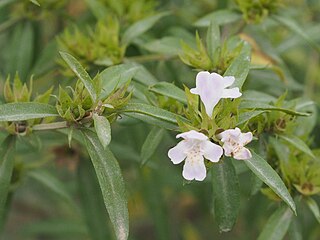
Fraser Island is a World Heritage-listed island along the south-eastern coast in the Wide Bay–Burnett region, Queensland, Australia. The name K'gari is the Indigenous name in the Butchulla language, while the name Gari is the Indigenous name in the Badtjala language. The island is approximately 250 kilometres (160 mi) north of the state capital, Brisbane, and is within the Fraser Coast Region local government area. The world heritage listing includes the island, its surrounding waters and parts of the nearby mainland.

Westringia is a genus of Australian shrubs. As with other members of the mint family their upper petal is divided into two lobes. There are four stamens - the upper two are fertile while the lower two are reduced to staminodes. The leaves are in whorls of 3 or 4.

Blandfordia grandiflora, commonly known as Christmas bells, is a flowering plant endemic to eastern Australia. It is a tufted perennial herb with narrow, channelled, linear leaves and between two and twenty large, drooping, bell-shaped flowers. The flowers are red with yellow tips, or sometimes entirely yellow. It is one of four species of Blandfordia known as Christmas bells, this one growing on the coast and nearby ranges between Sydney in New South Wales and Fraser Island in Queensland.
Westringia cremnophila, commonly known as Snowy River westringia, is a flowering plant in the family Lamiaceae, a rare shrub that is endemic to Victoria, Australia. It is a small shrub with leaves mostly in groups of three and white flowers.

Westringia eremicola, commonly known as slender westringia or slender western rosemary, is a flowering plant in the family Lamiaceae and is endemic to eastern Australia. It is a small shrub, with narrow leaves and pink, mauve to white flowers.

Westringia dampieri, commonly known as shore westringia, is a flowering plant in the family Lamiaceae, it grows in South Australia and Western Australia. It is a small, dense shrub with white, mauve, cream or purple flowers.
Mount Urah is a rural locality in the Fraser Coast Region, Queensland, Australia. In the 2016 census, Mount Urah had a population of 21 people.

Westringia davidii, also known as David's Westringia, is a species of plant in the mint family that is endemic to Australia.

Westringia amabilis is a species of flowering plant in the family Lamiaceae and grows in New South Wales and Queensland. It is a small shrub with ovate-shaped leaves and light mauve to white flowers and brownish spots in the throat.

Westringia parvifolia is a species of plant in the mint family that is endemic to Australia.

Westringia sericea, also known as native rosemary or silky rosemary, is a species of plant in the mint family that is endemic to Australia.

Westringia lucida, also known as Shining Westringia, is a species of plant in the mint family that is endemic to Australia.

Westringia blakeana is a flowering plant in the family Lamiaceae and grows in New South Wales and Queensland. It is a small shrub with mauve to whitish flowers with brown spots and leaves arranged in whorls.
Westringia longepedunculata is a species of plant in the mint family that is endemic to Australia. It is found in south-eastern Queensland, and is sometimes considered to be a synonym of Westringia cheelii.

Westringia rupicola is a species of plant in the mint family that is endemic to Australia.

Westringia rubiifolia, also known as sticky westringia, is a species of plant in the mint family that is endemic to the Australian state of Tasmania.

Westringia grandifolia is a species of plant in the mint family that is endemic to Australia. It occurs in wallum habitats in south-eastern Queensland, and is listed as Endangered under Queensland's Nature Conservation Act 1992.

Westringia brevifolia, also known as the greater shortleaf westringia, is a species of plant in the mint family that is endemic to Tasmania.

Westringia cheelii is a species of plant in the mint family that is endemic to Australia.

Westringia capitonia is a species of plant in the mint family that is endemic to Western Australia.


















